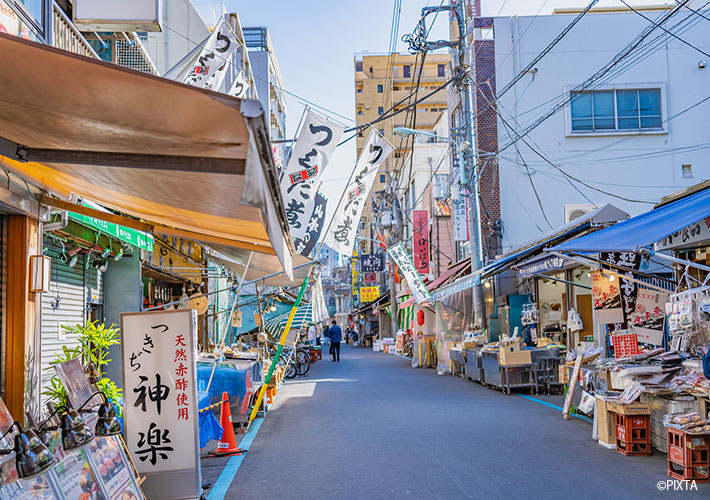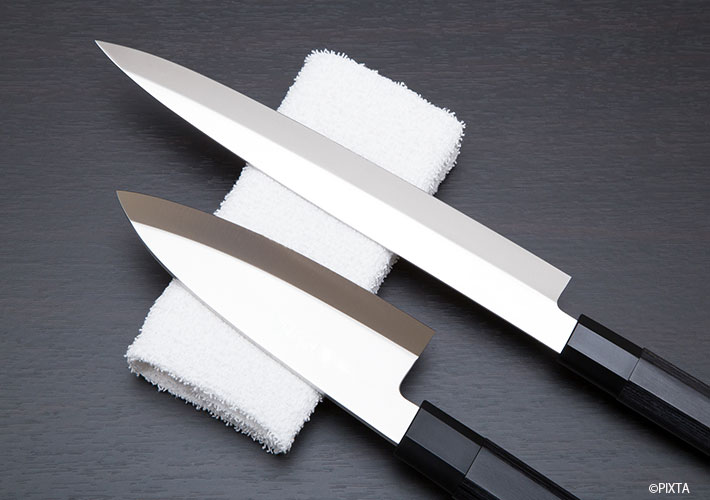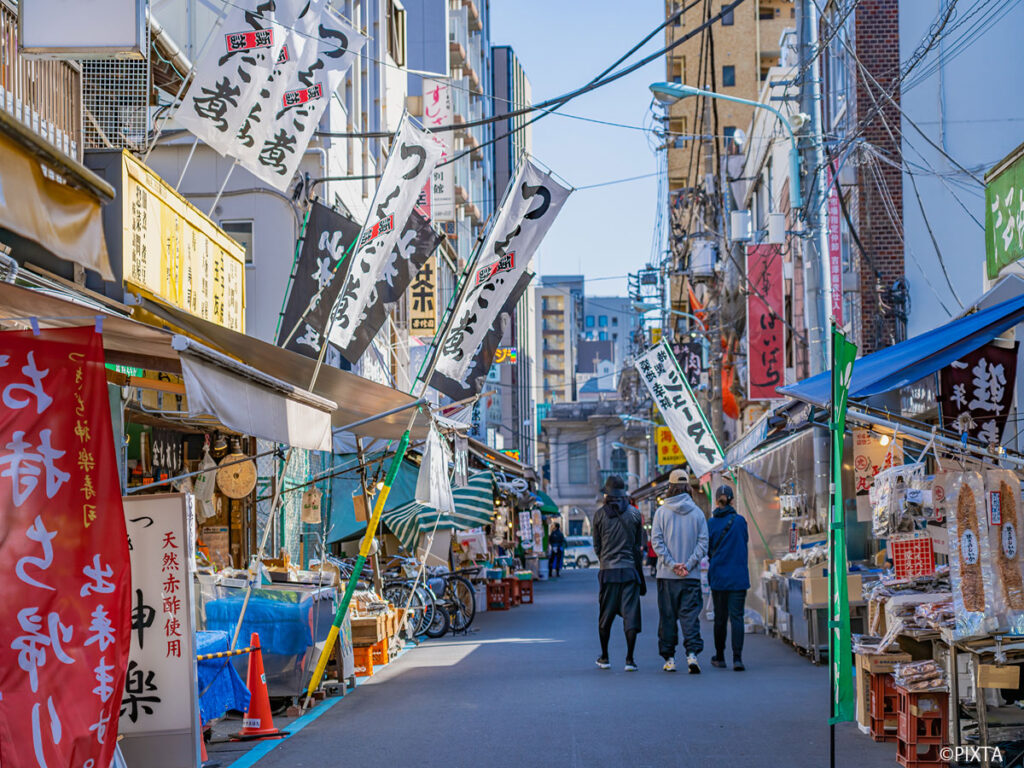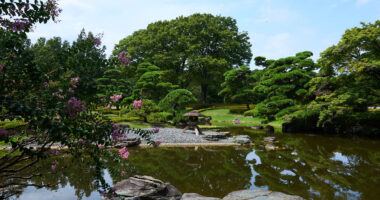Whether you’re trying to get a glimpse of Japan’s famously high-spirited fish market auctions, or hungering for the taste of the freshest seafood in Tokyo, you’ll want to make sure to stop by both of the 築地 Tsukiji and 豊洲 Toyosu districts. While Tsukiji’s famous wholesale fish market relocated to Toyosu, the area’s longstanding shops and restaurants still remain, preserving the neighborhood’s nostalgic atmosphere. Toyosu, meanwhile, now provides a more tourist-friendly and streamlined opportunity for travelers to observe fish market auctions, while also supplying Tsukiji restaurants with fresh seafood on a daily basis. Both fish market areas, new and old, are a must-visit for seafood lovers visiting Tokyo.
Access
While Tsukiji and Toyosu are relatively close to each other, it’s recommended to get off at different train stations depending on which area you are exploring. Those headed to Tsukiji will likely want to get off at Tsukijishijō Station (E18), which is accessible via the Ōedo LineLine. Toyosu, on the other hand, can be more easily reached from Shijō-mae Station (U14), which is on the Yurikamome Line.
Food and Drink
Tsukiji

Tsukiji’s outer market is still thriving with delicious seafood stalls and restaurants.
Tsukiji’s inner market may have relocated to Toyosu, but its outer marketplace area is still filled with old-fashioned restaurants and food stalls offering Japanese seafood delicacies. Because much of the fish is delivered daily and directly from Toyosu, Tsukiji’s restaurants are often lauded as the place to eat some of the freshest seafood in Tokyo.
Sushi: It should come as no surprise that Japan’s iconic dish is at the heart of the culinary scene in Tokyo’s famous fish market. Many restaurants in Tsukiji will open up in the morning, as early as 5:00, to serve freshly made sushi breakfasts to foodies who line up well before opening. If you’re looking to sample some of Tokyo’s most sought-out sushi, treat yourself to a set at Tsukiji.

A fresh sushi breakfast is a Tsukiji tradition. [Photo for illustrative purposes only]
Sashimi: Those looking to dig into fish as fresh as it comes will want to order sashimi platters in Tsukiji. Tuna in particular is highly recommended.
卵焼き Tamagoyaki: Tamagoyaki is a type of Japanese omelet that is typically made with eggs, sugar, and soy sauce. It’s a popular dish at Tsukiji, and there are many shops that specialize in making it.

If you’re not in the mood for seafood, Tsukiji’s tasty omelettes are a famous snack alternative.
海鮮丼 Kaisendon: Kaisendon is a type of donburi or rice bowl. Tsukiji is a great place to try seafood donburi, as there are many restaurants that serve bowls filled with fresh fish and shellfish.

Treat yourself to a rice bowl topped with some of Tokyo’s freshest seafood. [Photo for illustrative purposes only]
Toyosu
Sushi: Like Tsukiji, Toyosu is famous for its fresh seafood, and there are many sushi restaurants in the area that serve high-quality sushi made with fresh fish from the market.
Fruits and vegetables: In addition to seafood, Toyosu is also home to The Toyosu Fruit and Vegetable Market, which is a great place to find fresh and seasonal produce. You can try different varieties of Japanese fruits, such as melons, grapes, and persimmons. The market is known for selling rare and premium fruits and vegetables from all around Japan, some at prices that may be quite a surprise to international travelers!

Both Toyosu and Tsukiji are great places to get a taste for seafood-flavor packed ramen. [Photo for illustrative purposes only]
Ramen: Toyosu has a growing number of ramen shops that offer different styles of ramen, from classic tonkotsu (pork bone broth) to spicy miso. As you might imagine, there are quite a few seafood types as well.
Shopping
While neither Tsukiji nor Toyosu are particularly known as shopping centers, they both offer many shops selling souvenirs and fresh produce. Both fish markets also have many shops dedicated to traditional Japanese cutlery, so you can pick up a high-quality knife to prepare seafood at home.

Both Tsukiji and Toyosu are great places to pick up some quality Japanese cutlery–perfect for preparing seafood. [Photo for illustrative purposes only]
Sightseeing and Attractions
Tsukiji
Tsukiji is mostly known as a foodie hot spot, and not so much as a sightseeing area. However, there are still some things to do as you eat your way through town.
Food tours: There are many food tours available in Tsukiji that take you on a culinary journey through the market, where you can taste different types of seafood and Japanese street food.

Eat your way through Tsukiji on a food tour.
築地本願寺 Tsukiji Hongan-ji Temple: This large temple is located near the market and is famous for its unique Indian-style architecture.
Toyosu
Toyosu Fish Market: The Toyosu Fish Market is the largest seafood market in the world, and it offers a unique insight into the world of seafood in Japan. You can watch the tuna auctions, try fresh seafood, and learn about the different types of fish and seafood available in Japan. It’s important to note that these auctions take place very early in the morning, often around the time of the first train of the day, and also require a reservation. While tourists are more than welcome to watch, the fish market is a place of business, so it’s best to observe good manners and spectate politely.

Tuna auctions are one of the main attractions of The Toyosu Fish Market.
Cooking classes: There are cooking classes available in Toyosu that teach you how to prepare and cook traditional Japanese dishes using fresh seafood from the market.
Yumenoshima Tropical Greenhouse Dome: This large botanical garden is located near Toyosu and features a variety of tropical plants and flowers from all around the world.
Ultimately, the fish markets of Tsukiji and Toyosu offer a doubleheader of satisfaction for those looking to dive into the world of Japanese seafood. The older Tsukiji offers a bustling marketplace atmosphere, as well as a selection that allows travelers to sample some of the freshest seafood in Tokyo. Toyosu, on the other hand, takes you behind the scenes of Japan’s famous tuna auctions and offers an educational experience in regard to Japan’s seafood culture. If you’re looking to try out some high-quality sushi, sashimi, or other Japanese seafood, both Tsukiji and Toyosu are must-visits.












